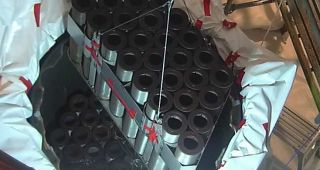Work crews prepare to place the final waste shipment into a vault at the Subsurface Disposal Area at the Idaho National Laboratory site. (Photo: DOE)
Plastic waste on a Galapagos beach. Sunlight, wind, and waves break down large plastic debris into smaller and smaller pieces to become microplastics. (Photo: F. Oberhaensli/IAEA)
The International Atomic Energy Agency has created a new program, NUclear TEChnology for Controlling Plastic Pollution (NUTEC Plastics), to address the global environmental impact of plastic pollution in oceans. It uses nuclear technology to monitor pollution and also to decrease the volume of plastic waste by using irradiation to complement traditional plastic recycling methods.
Artist’s rendering of the MMR project. (Image: USNC)
Global First Power’s (GFP) Micro Modular Reactor (MMR) project has moved to the formal license review phase with the Canadian Nuclear Safety Commission (CNSC), becoming the first small modular reactor to do so.
A rendering of the SHINE medical isotope production facility planned for construction in Veendam, the Netherlands. (Image: Shine)
SHINE Medical Technologies plans to locate its European medical isotope production facility in the Netherlands after a yearlong search and a review of more than 50 proposals from sites across Europe. The company announced on May 20 that construction at the site should begin in 2023 with commercial production starting in late 2025.
May 21, 2021, 2:41PMNuclear NewsCharles Forsberg and Eric Ingersoll TerraPower and GE Hitachi Nuclear Energy jointly developed the sodium-cooled Natrium reactor with the turbine hall, nitrate heat storage tanks, and cooling towers separated from the reactor at the back of the site.
The viability of nuclear power ultimately depends on economics. Safety is a requirement, but it does not determine whether a reactor will be deployed. The most economical reactor maximizes revenue while minimizing costs. The lowest-cost reactor is not necessarily the most economical reactor. Different markets impose different requirements on reactors. If the capital cost of Reactor A is 50 percent more than Reactor B but has characteristics that double the revenue, the most economical reactor is Reactor A.
The most important factor is an efficient supply chain, including on-site construction practices. This is the basis for the low capital cost of light water reactors from China and South Korea. The design of the reactor can significantly affect capital cost through its impact on the supply chain. The question is, how can advanced reactors boost revenue and reduce costs?
This figure, included in the ONWARDS funding opportunity announcement, shows how ARPA-E R&D programs address different stages of advanced reactor development. (Figure: ARPA-E)
The Department of Energy has announced up to $40 million in funding for a new Advanced Research Projects Agency-Energy (ARPA-E) program to conduct research and development into technologies for reprocessing and ultimately disposing of used nuclear fuel. The program, “Optimizing Nuclear Waste and Advanced Reactor Disposal Systems” (ONWARDS), announced on May 19, targets both open (once-through) and closed (reprocessing) fuel cycles to reduce the amount of waste produced from advanced reactors tenfold when compared to light water reactors.
J. Ernest Wilkins Jr. was honored posthumously by the University of Chicago at a special event held on March 2, 2007. (Photo: Dan Dry/Wikimedia Commons)
ANS past president (1974–1975) J. Ernest Wilkins Jr. was featured in a recent History.com article highlighting the unsung contributions that Black scientists made to the Manhattan Project.
Video still showing samples of red trinitite. (Source: University of Florence)
The world’s first atomic bomb test—code-named Trinity and conducted in New Mexico on July 16, 1945—had an unintended outcome that was only recently discovered.















 A highly anticipated report released yesterday by the International Energy Agency on how to transition the world to a net-zero energy system by 2050 calls for “nothing less than a complete transformation of how we produce, transport, and consume energy.” At the same time, the report,
A highly anticipated report released yesterday by the International Energy Agency on how to transition the world to a net-zero energy system by 2050 calls for “nothing less than a complete transformation of how we produce, transport, and consume energy.” At the same time, the report, 